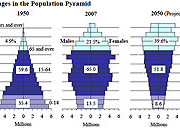The demographic time bomb is most marked in Japan
 The demographic time bomb – whereby the elderly population assumes a greater and greater proportion of the total population – is no more marked than in Japan.
The demographic time bomb – whereby the elderly population assumes a greater and greater proportion of the total population – is no more marked than in Japan.
Falling birth rates (as a result of abortion, contraception and delaying childbirth) and increasing longevity as a result of better medical care have created this situation.
If we look at the population age structure in Japan (see graph above) we can see how dramatically its shape has changed since 1950 and how much more it will change by 2050.
The same trends are spelt out numerically in the table below where different countries are compared.
The population pyramid of 1950 shows that Japan had a standard-shaped pyramid marked by a broad base. The shape of the pyramid, however, has changed dramatically as both the birth rate and death rate have declined.
In 1950 the population of elderly citizens (65 years and over) accounted for just 4.9% of the total population. This had risen to 21.5% by 2007 and will rise to 39.6% by 2050.
This growth of other people has been matched by a shrinking of the younger population. In 1950 those under 15 made up 35.4% of the total population but this had fallen to 13.5% by 2007 and will fall further to 8.6% by 2050.
Note also that those of working age (15-65) constituted 65% of the population in 2007 (two thirds) but will account for only 51% (half) by 2050.
They could well account for much less given that many of those in the 15-65 age group, as of now, might be in education, or alternatively not in education, employment or training.
The speed of aging of Japan’s population is much faster than in advanced Western European countries or the USA but the trends are similar throughout the industrialised world.
Add in increasing debt and rising unemployment and you have a very toxic cocktail indeed.
Unless something is done to reverse the demographic trends, ‘economic necessity’, together with the ‘culture of death’ ideology which is becoming more openly accepted, may well mean that the generation that killed its children through abortion will in turn be killed by its own children through euthanasia.
Some European politicians and economists have been chillingly open about the economic incentives for euthanasia.
Jacques Attali, the former president of the European Bank for Reconstruction and Development, said in 1981 in an article in L’Avenir de la vie:
‘As soon as he gets beyond 60-65 years of age, man lives beyond his capacity to produce, and he costs society a lot of money… euthanasia will be one of the essential instruments of our future societies.’
The real answer is not euthanasia. The real answer is in our grasp, but it requires a completely different mind-set to that which has led us, in our reckless pursuit of affluence and personal peace to mortgage our present, bankrupt our futures, and see those who rely on us as a burden rather than a privileged responsibility.
We need instead, as a society, to stop killing our children, build up our families, live more simply, give more generously and focus our priorities on providing for our dependents, especially the older generation which fought for our freedom in two world wars, provided for our health, education and welfare, and left us the legacy of wealth, comfort, peace and security which we have squandered and taken for granted.
Data on Japan obtained from online ‘Statistical Handbook of Japan’













Leave a Reply
Want to join the discussion?Feel free to contribute!